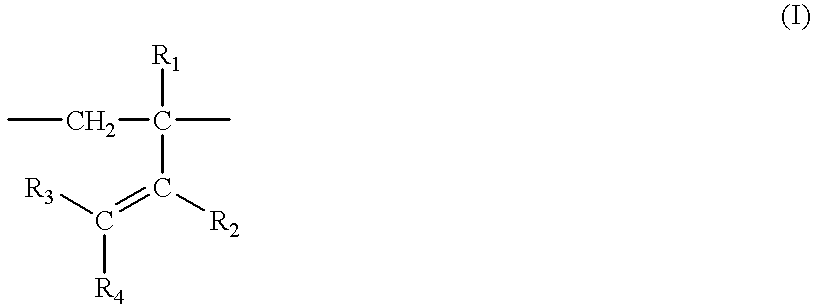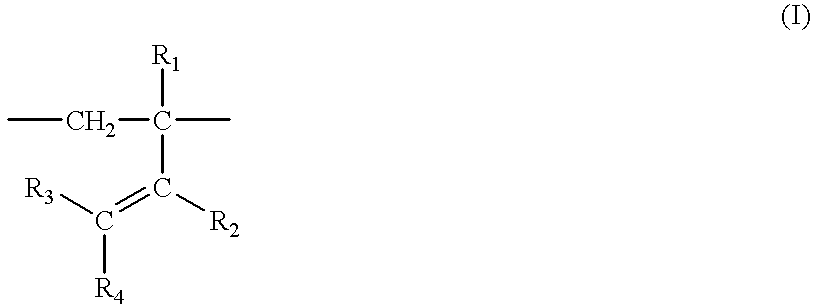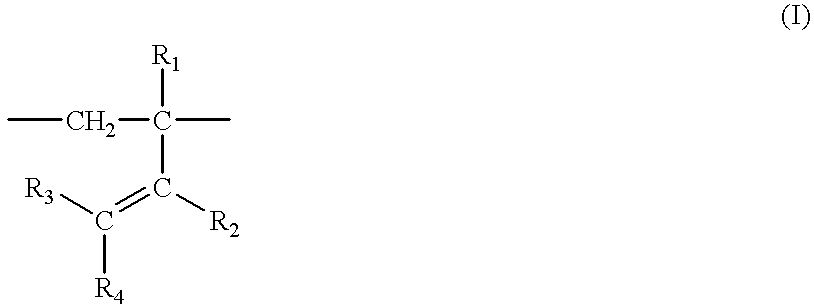Ethylene-vinyl alcohol copolymer composition and multilayered container using the same
a technology of ethylenevinyl alcohol and composition, applied in the direction of synthetic resin layered products, pipes, conductive materials, etc., can solve the problems of degradation of food contents due to oxidation when preserved for a long time, degrade the quality of contents, and the method (1) fails to provide sufficient oxygen barrier properties
- Summary
- Abstract
- Description
- Claims
- Application Information
AI Technical Summary
Problems solved by technology
Method used
Image
Examples
example 1
[0181] First, 96.5 parts by weight of the EVOH (A-11) shown in Table 2, 3.5 parts by weight of the thermoplastic resin (B-1) and 0.2121 parts by weight of cobalt (II) stearate (0.0200 parts by weight in terms of cobalt atoms) were dry-blended. The blend was extruded into pellets with a 30 mm .PHI. biaxial extruder (TEX-30SS-30CRW-2V, manufactured by Japan Steel Works, Ltd.) at 210.degree. C., a screw rotational speed of 300 rpm, and an extruded resin amount of 25 kg / hour. These pellets were dried at 30.degree. C. under reduced pressure for 16 hours to give resin composition pellets. The melt flow rate (210.degree. C.--2160 g load) of the resin composition was 11.8 g / 10 min. Observation of the cutting plane of the resin composition pellets through an electron microscope confirmed that the thermoplastic resin (B-1) were dispersed in the form of a particle having a size of about 1 .mu.m in the matrix of the EVOH.
[0182] The obtained resin composition pellets were extrusion-molded at an ...
example 2
[0187] First, 19.5 parts by weight of the EVOH (A-12) and 78.0 parts by weight of EVOH (A-21) shown in Table 2, 2.5 parts by weight of the thermoplastic resin (B-1), and 0.2121 parts by weight of cobalt (II) stearate (0.0200 parts by weight in terms of the cobalt atoms) were used to obtain a resin composition in the same manner as in Example 1. The melt flow rate (210.degree. C.--2160 g load) of this resin composition was 12.7 g / 10 min. Observation of the cutting plane of the resin composition pellets through an electron microscope confirmed that the thermoplastic resin (3-1) were dispersed in the form of a particle having a size of about 1 .mu.m in the matrix of the EVOH.
[0188] A film having a thickness of 20 .mu.m was obtained from this resin composition in the same manner as in Example 1. The haze value was measured and found to be 1.2%. When the oxygen absorption amount was measured, the results shown in FIG. 1 were obtained. The oxygen absorption rate of the film was 1.176 ml / m...
example 3
[0190] First, 38.0 parts by weight of the EVOH (A-12) and 57.0 parts by weight of EVOH (A-21), 5.0 parts by weight of the thermoplastic resin (B-1), and 0.2121 parts by weight of cobalt (II) stearate (0.0200 parts by weight in terms of the cobalt atoms) were used to obtain a resin composition in the same manner as in Example 1. The melt flow rate (210.degree. C.--2160 g load) of this resin composition was 12.0 g / 10 min. Observation of the cutting plane of the resin composition pellets through an electron microscope confirmed that the thermoplastic resin (B-1) were dispersed in the form of a particle having a size of about 1 .mu.m in the matrix of the EVOH.
[0191] A film having a thickness of 20 .mu.m was obtained from this resin composition in the same manner as in Example 1. The haze value was measured and found to be 1.1%. When the oxygen absorption amount was measured, the results shown in FIG. 1 were obtained. The oxygen absorption rate of the film was 1.398 ml / m.sup.2.multidot.d...
PUM
| Property | Measurement | Unit |
|---|---|---|
| refractive index | aaaaa | aaaaa |
| temperature | aaaaa | aaaaa |
| temperature | aaaaa | aaaaa |
Abstract
Description
Claims
Application Information
 Login to View More
Login to View More - R&D
- Intellectual Property
- Life Sciences
- Materials
- Tech Scout
- Unparalleled Data Quality
- Higher Quality Content
- 60% Fewer Hallucinations
Browse by: Latest US Patents, China's latest patents, Technical Efficacy Thesaurus, Application Domain, Technology Topic, Popular Technical Reports.
© 2025 PatSnap. All rights reserved.Legal|Privacy policy|Modern Slavery Act Transparency Statement|Sitemap|About US| Contact US: help@patsnap.com



